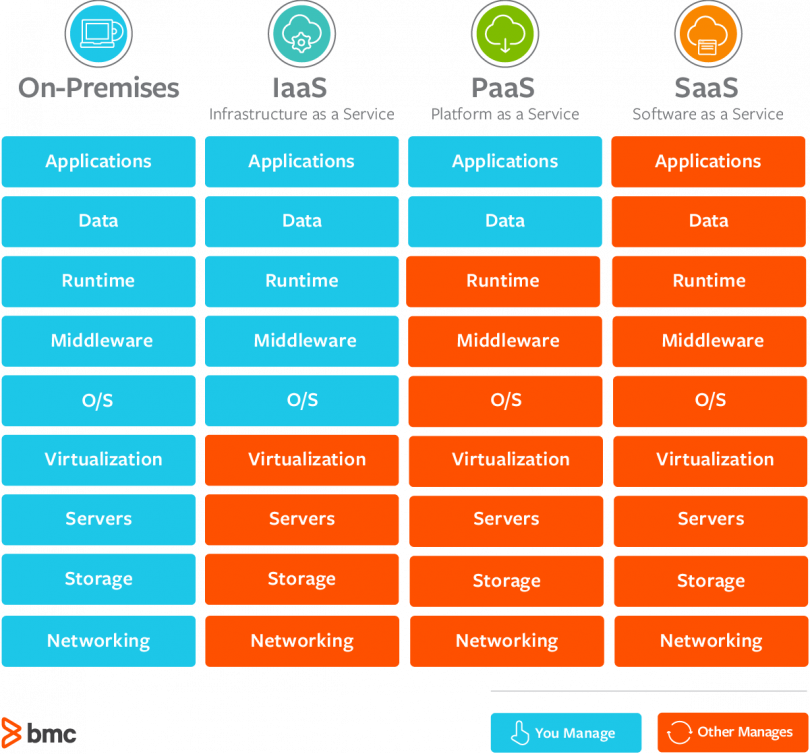Infrastructure as a service (Iaas)
Cloud computing services can be divided into three main types: infrastructure as a service (Iaas), platform as a service (Paas), and service as a subscription (SaaS). Each form of cloud computing has its architecture and intended purposes.
What is IaaS?
Infrastructure as a service (Iaas) is a form of delivering infrastructure services over the internet. It’s a hosting model that is responsible for different components of the operating infrastructure. The IaaS computing form provides high-grade APIs (application programming interfaces) to improve the level of data security and accompany other infrastructure components.
IaaS architecture and peculiarities
IaaS typically involves the use of a separate cloud orchestration technology. Its model entails virtual machine creation alongside hypervisors (physical hosts) that are aimed to support various virtual machines at once.
According to IaaS architecture, all of the essential infrastructure components are hosted by one cloud provider. They include:
- Physical data centers
- Networking hardware
- Storage
- Servers
- Additional services (monitoring, clustering, and billing tools, etc.).
This way, IaaS provides the same capabilities and technologies as a traditional data center, but you won’t have to maintain them physically. Still, compared to PaaS and SaaS, there are quite a few aspects that IaaS clients are responsible for managing themselves, such as runtime, middleware, applications, O/S, and data.

IaaS set of services improves the level of automation and operation of different infrastructure tasks. Using IaaS, users get the necessary capabilities, such as efficient load balance algorithms for better performance of apps.
The basic idea of IaaS products is to satisfy customers’ requirements for data storage and application maintenance. For instance, it’s possible to install an IaaS platform for backups and cloud workload storage. It’s important to mention that IaaS services give an opportunity to rationally allocate storage volumes and all the necessary data within the working platform.
Most common use cases for IaaS solutions
IaaS can be used to cope with different business tasks. A wide range of solutions for automation of various processes allows applying IaaS model for:
- Website hosting. Using IaaS solutions for running websites can be less expensive than traditional web hosting.
- Backup, recovery, and storage. IaaS requires no skilled staff to manage data, so it’s useful for handling growing storage needs. It can also be used to manage recovery and backup systems.
- Support for online applications (including networking options). Organizations can quickly deploy web apps on IaaS when needed.
- Testing and development operations. IaaS solutions make it easier to scale up test and development environments.
- Computing. This includes modeling, evaluating projects, and computer clustering.
- Analysis of big data. This includes patterns, algorithms, and trends practice.
It is worth noting that the IaaS cloud computing model is suitable for various purposes. For example, marketers can create their projects for data analysis before moving on to the lead generation process. At the same time, IaaS solutions can be optimal for email marketing, digital marketing, customer resource management, and internet of things (IoT) applications.

Who uses IaaS?
Companies of different sizes prefer IaaS solutions. For example, startups and small businesses can stick to it to avoid spending money and time on purchasing or creating software and hardware. At the same time, companies that experience rapid growth may prefer using IaaS solutions because they are scalable and allow changing hardware and software quickly.
Top-ranking IaaS global providers
According to the research of Stackify magazine, the top three IaaS providers are Amazon Web Services (AWS), Digital Ocean, and Microsoft Azure. They offer a vast range of computing services, including fast network, backup, storage, simple ADI, and other helpful options.
The full list of top ten IaaS examples is:
- Amazon Web Services (AWS)
- Digital Ocean
- Microsoft Azure
- Rackspace Open Cloud
- Google Compute Engine
- HP Enterprise Converged Infrastructure
- IBM SmartCloud
- Green Cloud Technologies
- CloudStack
- Linode
Users can try some of the available products and capabilities for free, as many of these providers have a free tier. Some providers guarantee extra options. Among them are template creation processes, virtual desktops, and multi-cloud platforms. To find an appropriate IaaS provider, the customer just needs to consider what options the pricing plan should contain.
IaaS advantages and disadvantages
The main advantage of the IaaS cloud-based computing model is high-level customization. People can use all the services offered by their IaaS providers for cost tracking, performance monitoring, network balancing, and other purposes. Other key advantages are:
- Low expenses. IaaS is budget-friendly for testing and monitoring processes. Using it, you won’t need to worry about maintaining hardware and network equipment.
- Scalability. The infrastructure makes sure that all the resources are available to its users when they need them.
- Disaster recovery is available, which brings data safety to the next level.
- The full range of digital tools for the fast launch of new products (application, website, etc.).
- Business orientation. IaaS helps companies concentrate their time and resources where they are needed (for example, focusing on consumers’ aims and requirements).
- Reliability. Both software and hardware are stable, reliable, and supportable.
- High-level security. All stored data is guarded against unauthorized access and other frauds.
The main shortcoming of the IaaS model is the lack of transparency for better system management. IaaS service providers fully control all the processes, which reduces the level of customization.

Wrapping it up
When it comes to using IaaS, many offers are helpful in creating a flexible platform with suitable computing, monitoring, and other solutions. IaaS can be more efficient for companies than owning and managing their infrastructure. But this is only possible if the provider is reliable.















